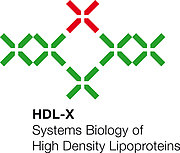HDL-X
Systems Biology of High Density Lipoproteins
The risks of developing diabetes and heart disease are linked to the levels of high-density lipoprotein cholesterol in the blood. The scientists involved in the HDL-X MRD Project intend to find out how this lipoprotein could be better used as a diagnostic indicator for patients at risk.
Low blood levels of high-density lipoprotein (HDL) cholesterol, also known as “good cholesterol”, are associated with increased risks of heart attack and diabetes mellitus. HDL particles exert many effects both in vitro and in vivo which seem to protect the human body from chemical or biological harm.
Nevertheless, HDL has not yet been successfully exploited for the prevention or treatment of heart disease or diabetes. An important reason for this shortfall is the structural and functional intricacy of HDL particles, which are complex, heterogeneous macromolecules with a cholesterol center surrounded by hundreds of lipid species and dozens of proteins as well as microRNAs. This complexity is compounded in pathological conditions due to both quantitative and qualitative molecular changes in HDL components, which are associated with both a loss of physiological function and the onset of pathological dysfunction.
The structural and functional complexity of HDL has until now prevented the clear assignment of particular molecules to the many functions of HDL. But detailed knowledge of the structure-function-relationships of HDL-associated molecules is a pre-requisite for uncovering their relative importance in the pathogenesis of HDL-associated diseases, and for exploiting them for treatment and diagnostics.
Prevention and therapy of heart disease and diabetes
The HDL-X MRD Project will for the first time address the complex function of HDL in health and disease through a systems medicine approach. The overall goal of HDL-X is to identify components and activities of HDL which are disturbed in patients with diabetes or heart disease, and which may be pivotal for the prevention of these disorders. To this end, the involved scientists will isolate HDL particles from the blood of both healthy subjects and patients. They will comprehensively and systematically characterize the macromolecules for their protein, microRNA and lipid abundances. The researchers will also characterize HDL’s biological interactions with endothelial cells, adipocytes, and myocytes, cells relevant for the pathogenesis of cardiovascular disease and diabetes.
The mathematical integration of the data will identify components of the high-density lipoproteins (HDL), either individually or in combination, that have the potential to serve as biomarkers for the diagnosis of individuals at increased risk of heart disease and diabetes. The models should also help develop personalized treatment strategies and monitor responses to therapy. Through this work, the HDL-X consortium will contribute to improving the management of two of the leading causes of death and disability.
| Principal Investigator | Prof. Dr. med. Arnold von Eckardstein, Institute of Clinical Chemistry, University Hospital Zurich |
| Involved Institutions | UZH/USZ, ETHZ |
| Number of Research Groups | 7 |
| Project Duration | June 2015 – May 2018 |
| Approved SystemsX.ch Funds | CHF 1.856 million |
Updated June 2015


